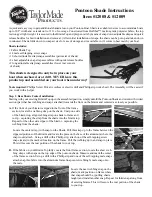
InstallatIon GuIde
1137 Emergency Light
Description
The 1137 Emergency Light is a battery powered, wireless LED light
activated by a loss of AC power output from your panel and may be
used as a stair or path light. The 1137 operates using the supplied 3.0
Vdc Lithium batteries.
Compatibility
All DMP 1100 Series Wireless Receivers and Panels
What is Included
The 1137 Emergency Light includes the following:
• One 1137 Emergency Light
• Two 3.0 Vdc Lithium batteries
• Serial number label
Emergency Light Serial Number
For your convenience, an additional pre-printed serial number label
is included. Prior to installing the light, record the serial number or
place the pre-printed serial number label on the 1137 base (see Figure
3). This number is required during programming. As needed, use the
zone name and number label to identify a specific Emergency Light.
Programming the Emergency Light in the Panel
Refer to the panel programming guide as needed. Program the device as an AC Power Trouble Output in ZONE
INFORMATION during panel programming. At the Serial Number prompt, enter the eight-digit serial number. Continue
to program the zone as directed in the panel programming guide.
LED Survey
The 1137 Emergency Light provides a survey capability to allow one person to confirm communication with the
receiver. The 1137 Emergency Light Status LED turns on whenever data is sent to the receiver then immediately
turns off when the receiver acknowledgement is received.
Pressing the button sends data to the receiver to confirm operation. When the Emergency Light does not receive
an acknowledgement from the receiver the LED remains on for approximately eight seconds to indicate that
communication is not established. Communication is also faulty when the LED flashes multiple times in quick
succession. Relocate the light or receiver until the LED immediately turns off indicating the light and receiver are
communicating properly. Proper communication between the light and receiver is verified when for each press of the
button, the LED blinks immediately on and immediately off. Repeat this test to confirm five separate consecutive
LED blinks. Any indication otherwise means proper communication has not been established.
Figure 1: 1137 Emergency Light
Figure 4: Installing the Top Housing
Figure 3: Double-Sided Tape Mount
SERIAL #
Figure 2: Screw Mount






















